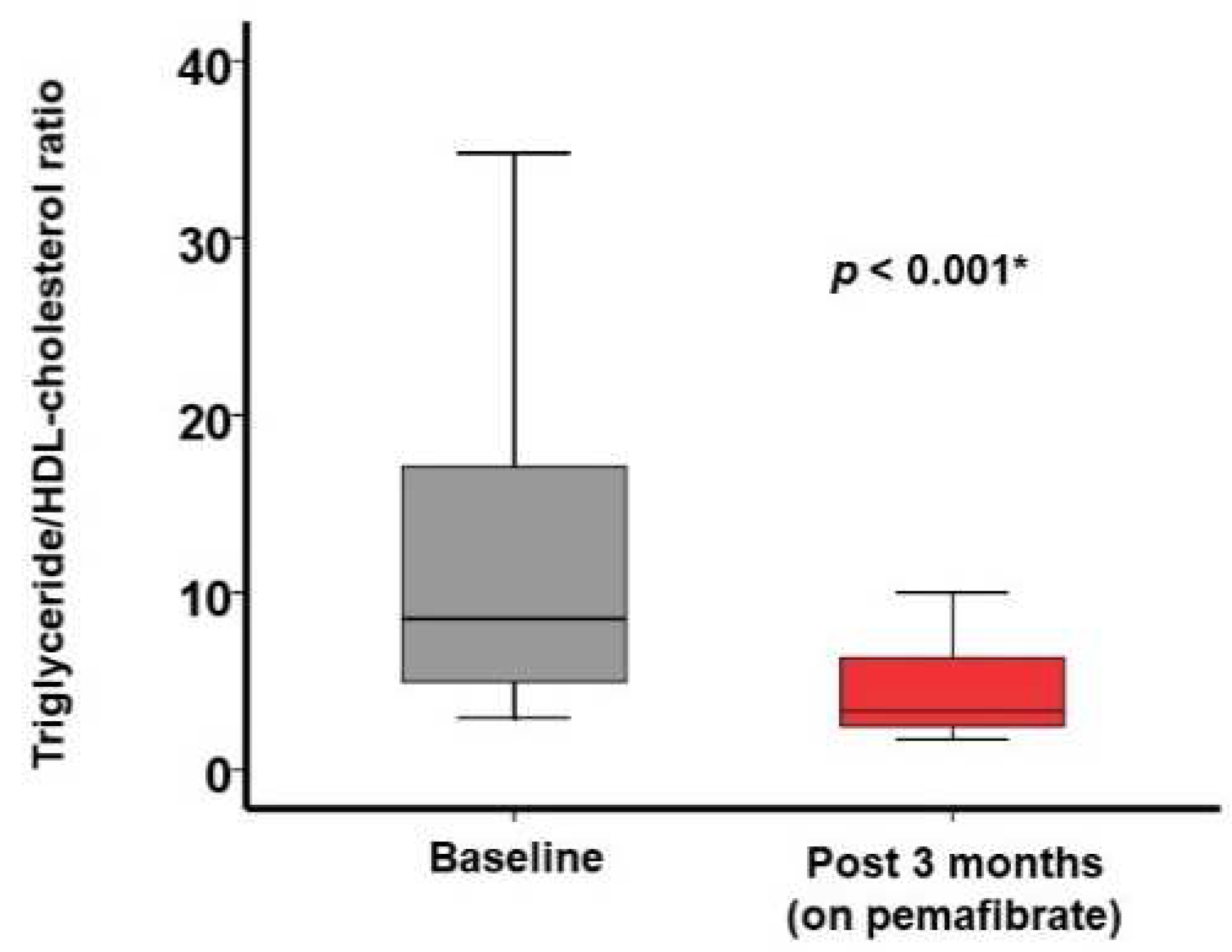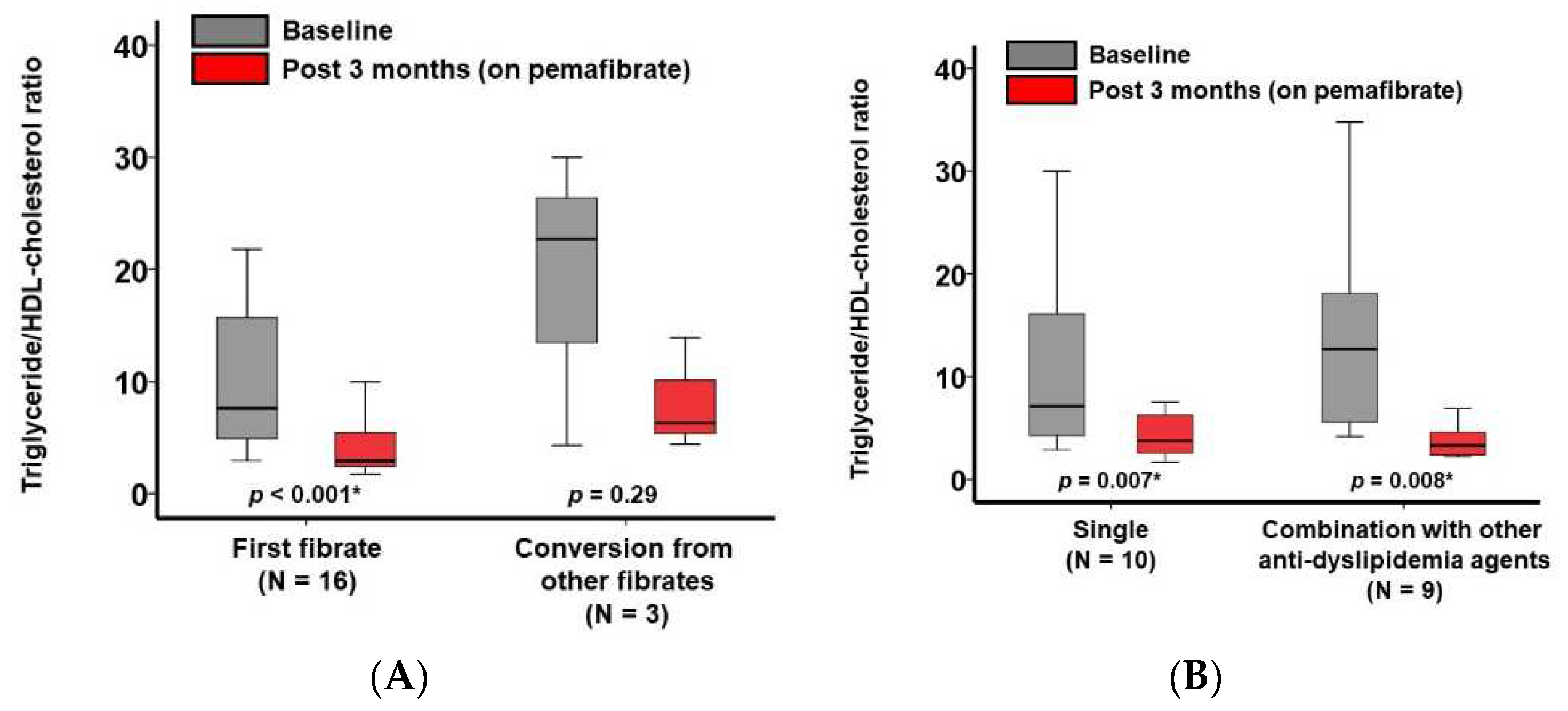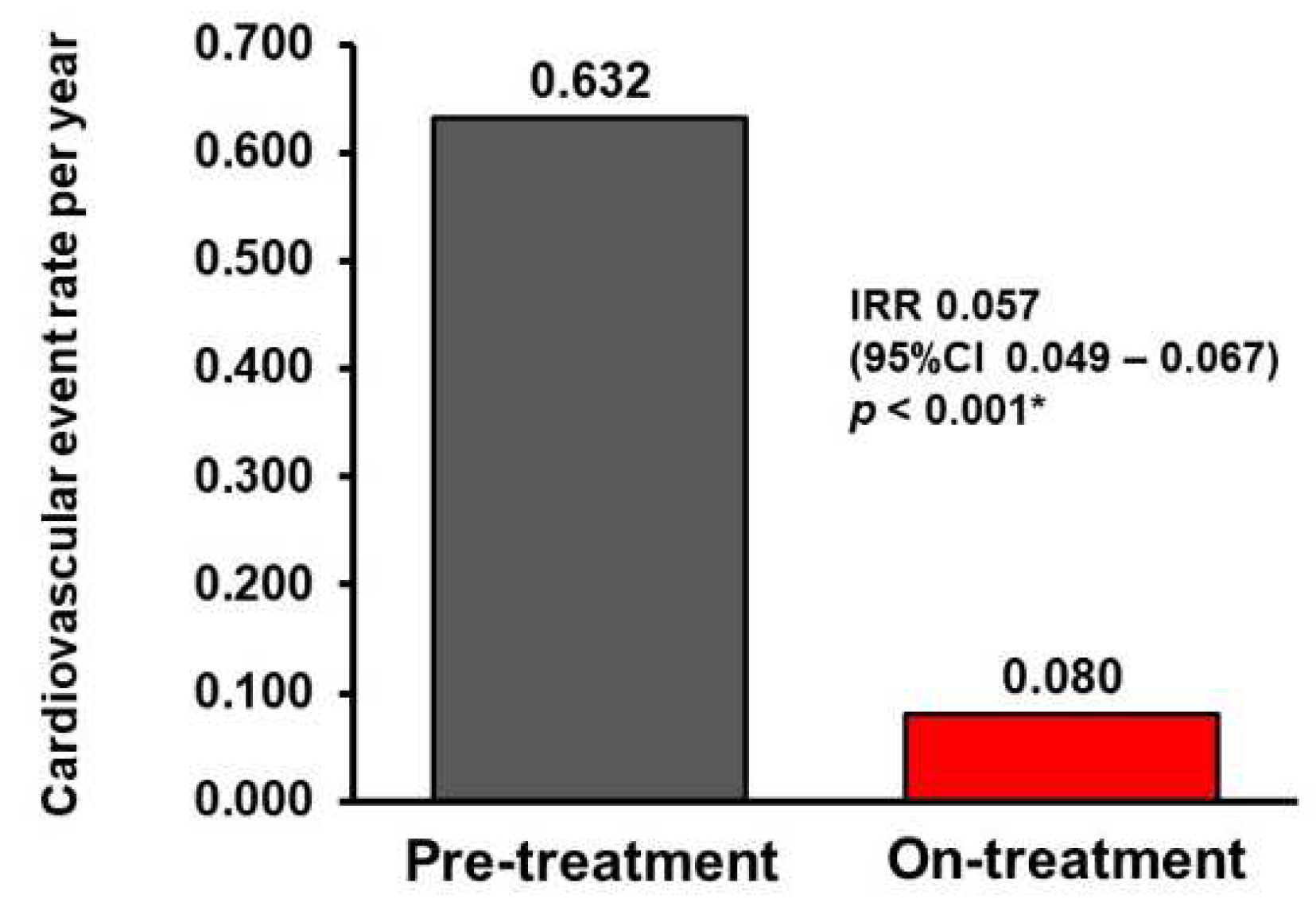Association between Pemafibrate Therapy and Triglyceride to HDL-Cholesterol Ratio
Abstract
:1. Background
2. Methods
2.1. Patient Selection
2.2. Biomarker Measurement
2.3. Other Clinical Data
2.4. Statistical Analysis
3. Results
3.1. Baseline Characteristics
3.2. Trends in Triglyceride/HDL-Cholesterol Ratio (Primary Endpoint)
3.3. Trends in Other Laboratory Data
3.4. Trends in Cardiovascular Event Rate
4. Discussion
5. Conclusions
Author Contributions
Funding
Institutional Review Board Statement
Informed Consent Statement
Data Availability Statement
Conflicts of Interest
References
- Kazi, D.S.; Penko, J.M.; Bibbins-Domingo, K. Statins for Primary Prevention of Cardiovascular Disease: Review of Evidence and Recommendations for Clinical Practice. Med. Clin. N. Am. 2017, 101, 689–699. [Google Scholar] [CrossRef] [PubMed]
- Cholesterol Treatment Trialists’ (CTT) Collaboration; Fulcher, J.; O’Connell, R.; Voysey, M.; Emberson, J.; Blackwell, L.; Mihaylova, B.; Simes, J.; Collins, R.; Kirby, A.; et al. Efficacy and safety of LDL-lowering therapy among men and women: Meta-analysis of individual data from 174,000 participants in 27 randomised trials. Lancet 2015, 385, 1397–1405. [Google Scholar] [PubMed]
- Barter, P.J.; Rye, K.A. Cardioprotective properties of fibrates: Which fibrate, which patients, what mechanism? Circulation 2006, 113, 1553–1555. [Google Scholar] [CrossRef] [PubMed] [Green Version]
- Ferri, N.; Corsini, A.; Sirtori, C.; Ruscica, M. PPAR-alpha agonists are still on the rise: An update on clinical and experimental findings. Expert Opin. Investig. Drugs 2017, 26, 593–602. [Google Scholar] [CrossRef] [PubMed]
- The ACCORD Study Group; Ginsberg, H.N.; Elam, M.B.; Lovato, L.C.; Crouse III, J.R.; Leiter, L.A.; Linz, P.; Friedewald, W.T.; Buse, J.B.; Gerstein, H.C.; et al. Effects of combination lipid therapy in type 2 diabetes mellitus. N. Engl. J. Med. 2010, 362, 1563–1574. [Google Scholar]
- Araki, E.; Yamashita, S.; Arai, H.; Yokote, K.; Satoh, J.; Inoguchi, T.; Nakamura, J.; Maegawa, H.; Yoshioka, N.; Tanizawa, Y.; et al. Effects of Pemafibrate, a Novel Selective PPARalpha Modulator, on Lipid and Glucose Metabolism in Patients With Type 2 Diabetes and Hypertriglyceridemia: A Randomized, Double-Blind, Placebo-Controlled, Phase 3 Trial. Diabetes Care 2018, 41, 538–546. [Google Scholar] [CrossRef] [Green Version]
- Araki, E.; Yamashita, S.; Arai, H.; Yokote, K.; Satoh, J.; Inoguchi, T.; Nakamura, J.; Maegawa, H.; Yoshioka, N.; Tanizawa, Y.; et al. Efficacy and safety of pemafibrate in people with type 2 diabetes and elevated triglyceride levels: 52-week data from the PROVIDE study. Diabetes Obes. Metab. 2019, 21, 1737–1744. [Google Scholar] [CrossRef]
- Yokote, K.; Yamashita, S.; Arai, H.; Araki, E.; Suganami, H.; Ishibashi, S.; On Behalf of the K-Study Group. Long-Term Efficacy and Safety of Pemafibrate, a Novel Selective Peroxisome Proliferator-Activated Receptor-alpha Modulator (SPPARMalpha), in Dyslipidemic Patients with Renal Impairment. Int. J. Mol. Sci. 2019, 20, 706. [Google Scholar] [CrossRef] [Green Version]
- Arai, H.; Yamashita, S.; Yokote, K.; Araki, E.; Suganami, H.; Ishibashi, S.; on behalf of the K-877 Study Group. Efficacy and Safety of Pemafibrate Versus Fenofibrate in Patients with High Triglyceride and Low HDL Cholesterol Levels: A Multicenter, Placebo-Controlled, Double-Blind, Randomized Trial. J. Atheroscler. Thromb. 2018, 25, 521–538. [Google Scholar] [CrossRef] [Green Version]
- Arai, H.; Yamashita, S.; Yokote, K.; Araki, E.; Suganami, H.; Ishibashi, S.; K-877 Study Group. Efficacy and safety of K-877, a novel selective peroxisome proliferator-activated receptor alpha modulator (SPPARMalpha), in combination with statin treatment: Two randomised, double-blind, placebo-controlled clinical trials in patients with dyslipidaemia. Atherosclerosis 2017, 261, 144–152. [Google Scholar] [CrossRef] [Green Version]
- Ishibashi, S.; Yamashita, S.; Arai, H.; Araki, E.; Yokote, K.; Suganami, H.; Fruchart, J.-S.; Kodama, T.; K-877-04 Study Group. Effects of K-877, a novel selective PPARalpha modulator (SPPARMalpha), in dyslipidaemic patients: A randomized, double blind, active- and placebo-controlled, phase 2 trial. Atherosclerosis 2016, 249, 36–43. [Google Scholar] [CrossRef] [Green Version]
- Ishibashi, S.; Arai, H.; Yokote, K.; Araki, E.; Suganami, H.; Yamashita, S.; K-877 Study Group. Efficacy and safety of pemafibrate (K-877), a selective peroxisome proliferator-activated receptor alpha modulator, in patients with dyslipidemia: Results from a 24-week, randomized, double blind, active-controlled, phase 3 trial. J. Clin. Lipidol. 2018, 12, 173–184. [Google Scholar] [CrossRef] [PubMed] [Green Version]
- Maruyama, C.; Imamura, K.; Teramoto, T. Assessment of LDL particle size by triglyceride/HDL-cholesterol ratio in non-diabetic, healthy subjects without prominent hyperlipidemia. J. Atheroscler. Thromb. 2003, 10, 186–191. [Google Scholar] [CrossRef] [Green Version]
- Vallejo-Vaz, A.J.; Fayyad, R.; Boekholdt, M.; Hovingh, G.K.; Kastelein, J.J.; Melamed, S.; Barter, P.; Waters, D.D.; Ray, K.K. Triglyceride-Rich Lipoprotein Cholesterol and Risk of Cardiovascular Events Among Patients Receiving Statin Therapy in the TNT Trial. Circulation 2018, 138, 770–781. [Google Scholar] [CrossRef] [PubMed]
- Yamashita, S.; Masuda, D.; Matsuzawa, Y. Pemafibrate, a New Selective PPARalpha Modulator: Drug Concept and Its Clinical Applications for Dyslipidemia and Metabolic Diseases. Curr. Atheroscler. Rep. 2020, 22, 5. [Google Scholar] [CrossRef] [PubMed] [Green Version]
- Lamarche, B.; Lemieux, I.; Despres, J.P. The small, dense LDL phenotype and the risk of coronary heart disease: Epidemiology, patho-physiology and therapeutic aspects. Diabetes Metab. 1999, 25, 199–211. [Google Scholar] [PubMed]
- Arai, H.; Kokubo, Y.; Watanabe, M.; Sawamura, T.; Ito, Y.; Minagawa, A.; Okamura, T.; Miyamato, Y. Small dense low-density lipoproteins cholesterol can predict incident cardiovascular disease in an urban Japanese cohort: The Suita study. J. Atheroscler. Thromb. 2013, 20, 195–203. [Google Scholar] [CrossRef] [Green Version]
- Hoogeveen, R.C.; Gaubatz, J.W.; Sun, W.; Dodge, R.C.; Crosby, J.R.; Jiang, J.; Couper, D.; Virani, S.S.; Kathiresan, S.; Boerwinkle, E.; et al. Small dense low-density lipoprotein-cholesterol concentrations predict risk for coronary heart disease: The Atherosclerosis Risk in Communities (ARIC) study. Arterioscler. Thromb. Vasc. Biol. 2014, 34, 1069–1077. [Google Scholar] [CrossRef] [Green Version]
- Maki, T.; Maeda, Y.; Sonoda, N.; Makimura, H.; Kimura, S.; Maeno, S.; Takayanagi, R.; Inoguchi, T. Renoprotective effect of a novel selective PPARalpha modulator K-877 in db/db mice: A role of diacylglycerol-protein kinase C-NAD(P)H oxidase pathway. Metabolism 2017, 71, 33–45. [Google Scholar] [CrossRef]
- Aomura, D.; Harada, M.; Yamada, Y.; Nakajima, T.; Hashimoto, K.; Tanaka, N.; Kamijo, Y. Pemafibrate Protects against Fatty Acid-Induced Nephropathy by Maintaining Renal Fatty Acid Metabolism. Metabolites 2021, 11, 372. [Google Scholar] [CrossRef]
- Pradhan, A.D.; Paynter, N.P.; Everett, B.M.; Glynn, R.J.; Amarenco, P.; Elam, M.; Ginsberg, H.; Hiatt, W.R.; Ishibashi, S.; Koenig, W.; et al. Rationale and design of the Pemafibrate to Reduce Cardiovascular Outcomes by Reducing Triglycerides in Patients with Diabetes (PROMINENT) study. Am. Heart J. 2018, 206, 80–93. [Google Scholar] [CrossRef] [PubMed]



| Total (N = 19) | Pemafibrate Alone (N = 10) | Combination with other Agents (N = 9) | p Value | |
|---|---|---|---|---|
| Demographics | ||||
| Age, years | 63 (54, 67) | 61 (40, 64) | 61 (54, 72) | |
| Men | 14 (74%) | 7 (70%) | 7 (78%) | 0.73 |
| Body mass index, kg/m2 | 23.2 (21.1, 25.7) | 23.1 (20.9, 24.5) | 23.3 (21.1, 25.3) | 0.36 |
| Comorbidity | ||||
| Hypertension | 13 (68%) | 6 (60%) | 7 (78%) | 0.41 |
| Dyslipidemia | 19 (100%) | 10 (100%) | 9 (100%) | 1 |
| Diabetes mellitus | 12 (63%) | 5 (50%) | 7 (78%) | 0.21 |
| Atrial fibrillation | 9 (47%) | 5 (50%) | 4 (44%) | 0.81 |
| Fibrate use | ||||
| As a first fibrate | 16 (74%) | 7 (70%) | 9 (100%) | 0.073 |
| As a conversion from other fibrates | 3 (16%) | 3 (30%) | 0 (0%) | 0.073 |
| Baseline | 3 Months | p Value | |
|---|---|---|---|
| Lipid parameters | |||
| Triglyceride, mg/dL | 304 (197, 589) | 156 (117, 254) | <0.001 * |
| LDL-cholesterol, mg/dL | 107 (75, 127) | 97 (79, 141) | 0.39 |
| HDL-cholesterol, mg/dL | 46 (36, 49) | 49 (41, 55) | 0.001 * |
| Triglyceride-rich lipoprotein-cholesterol, mg/dL | 61 (39, 73) | 25 (21, 41) | <0.001 * |
| Total cholesterol, mg/dL | 212 (164, 220) | 187 (151, 211) | 0.016 * |
| Other laboratory data | |||
| Hemoglobin, g/dL | 14.5 (12.6, 16.0) | 13.7 (12.7, 15.2) | 0.1 |
| Estimated glomerular filtration ratio, mL/min/1.73 m2 | 67.1 (38.9, 74.5) | 64.7 (36.1, 81.6) | 0.64 |
| Plasma B-type natriuretic peptide, pg/mL | 73 (65, 89) | 43 (34, 44) | 0.11 |
| Serum C-reactive protein, mg/dL | 0.26 (0.11, 0.29) | 0.21 (0.08, 0.25) | 0.076 |
| Urine protein, g/g creatinine | 0.03 (0.00, 0.48) | 0.00 (0.00, 0.21) | 0.021 * |
Publisher’s Note: MDPI stays neutral with regard to jurisdictional claims in published maps and institutional affiliations. |
© 2022 by the authors. Licensee MDPI, Basel, Switzerland. This article is an open access article distributed under the terms and conditions of the Creative Commons Attribution (CC BY) license (https://creativecommons.org/licenses/by/4.0/).
Share and Cite
Imamura, T.; Narang, N.; Kinugawa, K. Association between Pemafibrate Therapy and Triglyceride to HDL-Cholesterol Ratio. J. Clin. Med. 2022, 11, 2820. https://doi.org/10.3390/jcm11102820
Imamura T, Narang N, Kinugawa K. Association between Pemafibrate Therapy and Triglyceride to HDL-Cholesterol Ratio. Journal of Clinical Medicine. 2022; 11(10):2820. https://doi.org/10.3390/jcm11102820
Chicago/Turabian StyleImamura, Teruhiko, Nikhil Narang, and Koichiro Kinugawa. 2022. "Association between Pemafibrate Therapy and Triglyceride to HDL-Cholesterol Ratio" Journal of Clinical Medicine 11, no. 10: 2820. https://doi.org/10.3390/jcm11102820
APA StyleImamura, T., Narang, N., & Kinugawa, K. (2022). Association between Pemafibrate Therapy and Triglyceride to HDL-Cholesterol Ratio. Journal of Clinical Medicine, 11(10), 2820. https://doi.org/10.3390/jcm11102820







